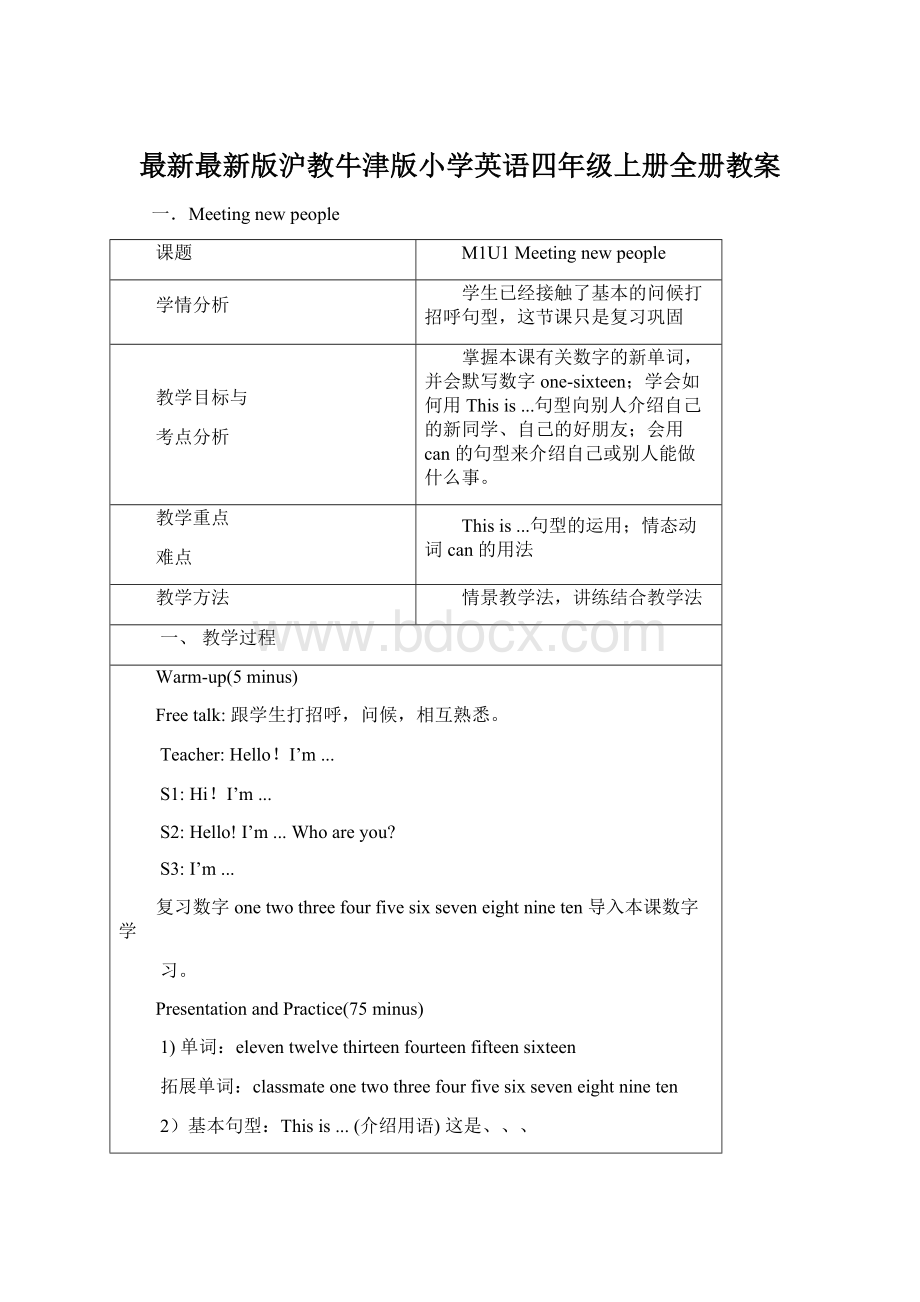最新最新版沪教牛津版小学英语四年级上册全册教案.docx
《最新最新版沪教牛津版小学英语四年级上册全册教案.docx》由会员分享,可在线阅读,更多相关《最新最新版沪教牛津版小学英语四年级上册全册教案.docx(63页珍藏版)》请在冰豆网上搜索。

最新最新版沪教牛津版小学英语四年级上册全册教案
一.Meetingnewpeople
课题
M1U1Meetingnewpeople
学情分析
学生已经接触了基本的问候打招呼句型,这节课只是复习巩固
教学目标与
考点分析
掌握本课有关数字的新单词,并会默写数字one-sixteen;学会如何用Thisis...句型向别人介绍自己的新同学、自己的好朋友;会用can的句型来介绍自己或别人能做什么事。
教学重点
难点
Thisis...句型的运用;情态动词can的用法
教学方法
情景教学法,讲练结合教学法
一、教学过程
Warm-up(5minus)
Freetalk:
跟学生打招呼,问候,相互熟悉。
Teacher:
Hello!
I’m...
S1:
Hi!
I’m...
S2:
Hello!
I’m...Whoareyou?
S3:
I’m...
复习数字onetwothreefourfivesixseveneightnineten导入本课数字学
习。
PresentationandPractice(75minus)
1)单词:
eleventwelvethirteenfourteenfifteensixteen
拓展单词:
classmateonetwothreefourfivesixseveneightnineten
2)基本句型:
Thisis...(介绍用语)这是、、、
Seeyou.再见。
-Nicetoseeyou.很高兴见到你。
-Nicetoseeyoutoo.也很高兴见到你。
基于课本进行讲解。
Part1:
Lookandsay
Goodmorning,Peter.
Goodmorning,Kitty.
Thisismysister.HernameisSally.She’stwelve.
Andthisismybrother.HisnameisPaul.He’sonlysix.
Hi,Sally.Hi,Paul.MynameisKitty.I’mPeter’sclassmate.
Hi,Kitty.
Wearegoingtothepark.Goodbye,Kitty.
Part2:
Askandanswer
Showaphotoofyourfriend.Thentalkabouthim/her.
Thisismyfriend.Hisname’sDanny.He’snine.Hecanrideabicycle.
Thisismyfriend.Hername’sTracy.She’sthirteen.Shecanskip.
S:
Thisismy...His/Hername’s...
He’s/She’s...(age)
He/Shecan...
3)语法:
1.形容词性物主代词my,her,his,your
在英语中有物主代词,它可以分成名词性的和形容词性的。
形容词性物主代词相当于形容
词,置于名词前,在句子中用于修饰名词,做定语,后面必须跟一个名词。
例如:
Thisismybrother.HisnameisTom.这是我的哥哥。
他叫汤姆。
形容词性物主代词有人称和数的变化,
单数形式:
my(我的),your(你的),his/her/its(他的、她的、它的)。
复数形式:
our(我们的),your(你们的),their(他们的)。
练习:
1.Thisismybook.areoverthere.
A.YourB.YoursC.YouD.Mine
2.Whosepenisit?
It’s.
A.herB.hersC.sheD.his
3.__bagisnewand__isnew,too.
A.Our,heB.Ours,hisC.My,hisD.My,her
4.Thisroomisours,andthatoneis__.
A.theyB.themC.theirsD.their
5.Whosepencilsarethere?
They’re__.
A.myB.meC.mineD.our
6.Isthenewwatch__?
Yes,it’s__.
A.you,meB.yours,mineC.your,myD.your,mine
7.Whoseshoesarethese?
Theyare__.
A.meB.mineC.myD.I
8.Sheisastudent,__nameisHanMei.
A.itsB.herC.hersD.his
9.It’sadog.Idon’tknow__name.
A.its’B.itsC.itD.it’s
10.Thisrulerisn’tmine.Ithinkitis__.
A.heB.himC.hisD.her
11.__schoolbagisbeautiful.But__ismorebeautiful.
A.Jims,myB.Jim’s,mine
C.Jim’s,meD.Jims’,I
12.__amaboyand__isagirl.
A.My,sheB.I,herC.I,sheD.Mine,she
13.Ilike__newdress.
A.SheB.herC.hersD.his
14.Ioftenhelp__motherdo__housework(家务活)。
A.me,sheB.mine,herC.my,herD.I,hers
15.Isthat__hat?
No,it’snot__.It’s__.
A.your,my,TomsB.you,mine,Tom’s
C.yours,mine,TomD.your,mine,Tom’s
2.情态动词Can
can后的动词必须是原形,否定形式can’t
例如:
肯定句:
Hecanswimveryfast.
否定句:
Hecan’tsing.
疑问句:
Canheclimbatree?
回答:
Yes,hecan./No,hecan’t.
练习:
将下面各组词组成句子
1.________________________(an,aeroplane,hear,Lucy,can)
2.____________________________(not,he,dance,can)
3.____________________________?
(you,can,see,what)
4.____________________________(can,see,not,we,you)
5._____________________________.(I,can,help,you)
6._____________________________?
(I,can,do,what)
7._____________________________?
(you,can,hearme)
8._____________________________?
(you,can,dance)
3.名词所有格:
所有格的构成方法:
(1)一般情况(包括单数名词和不带词尾s的复数名词)加-’s:
children’sbooks儿童图书
today’spaper今天的报纸
(2)带词尾s的复数名词只加省字撇(‘):
girls’school女子学校
theSmiths’car史密斯家的小汽车
注:
带词尾s的单数名词,通常仍加’s:
theboss’splan老板的计划
thehostess’sworry女主人的担心
(3)带词尾s带词尾的人名,可加’s或只加省字撇(‘):
Dickens’novels狄更斯的小说
Charles’sjob查理斯的工作
注:
不带词尾-s却以咝音结尾者,一律加’s却以咝音结尾者,
Marx’sworks马克思的著作Closure(10minus)
1)带领学生复习总结今天所学单词和句型,一般是提问的方式。
2)放学前一个一个学生检查今天单词和基本句型的朗读。
Unit2Canyouswim
课题
M1U2
学情分析
学生在之前已经接触过了情态动词can的用法
教学目标与
考点分析
学会用can和can’t句型来介绍自己或别人能做什么事情或者不能做什么事情。
教学重点
难点
情态动词can的用法
教学方法
交际法,讲练结合法,情景教学法
一、教学过程
1.Warm-up(5minus)
Freetalk:
用之前所学的can句型与学生进行简单的对话,引入今天的课程。
T:
Canyouswim?
S1:
Yes,Ican.
S2:
No,Ican’t.
T:
Canyourmothercook?
S1:
Yes,Ican.
S2:
No,Ican’t.
2.PresentationandPractice(75minus)
1)单词:
paintdrawreadwriteswimjump
climb爬draw画画paint用颜料画画swim游泳read读write写
jump跳hop单脚跳picture画图dream梦interview采访
guest嘉宾everyone大家,每个人fast快high高very很,非常
welcome欢迎both两个都dolphin海豚wasp黄蜂crisp薯片
2)句型:
Canshe/he...?
Yes,she/hecan.
No,he/shecan’t.
Welcometo...
基于课本的简练
Part1:
Listenandenjoy
Canyourpongsing?
No,hecan’t.
No,hecan’t.
Canyourfishread?
No,hecan’t.
No,hecan’t.
Canyourcatclimbthetree?
Yes,hecan.
Yes,hecan.
Canyourbrothercounttothree?
Yes,hecan.
Yes,hecan.
P